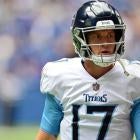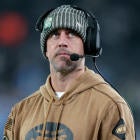
Jimmy Graham was the centerpiece of one of the offseason's biggest trades. He was dealt from New Orleans to Seattle, where he now figures to be the No. 1 passing game target for Russell Wilson's Seahawks. Already, though, things are a little different in Graham's new digs than they were where he used to play.
“Yeah, I’m blocking here,” Graham said Monday, per the Seahawks' official web site. “Out there the last few I was pretty banged up so midway through the year I kind of stopped blocking, and I just routed people up. Now here, I’m blocking quite a bit and I love it. It’s very important for me to be a part of that here because that’s about 75 percent of the offense here, and when you have a back like that you want to be in there on those explosive runs, and you want to be a part of that.”
It's hard to find two offenses more disparate in terms of their play distribution over the last few years than the Saints and Seahawks. New Orleans placed much of the offensive responsibility on the shoulder of quarterback Drew Brees, while the Seattle offense has been powered by the engine inside Marshawn Lynch's thighs.
| Pass Play Percentage (via TeamRankings.com) |
||
| Year | Seattle | New Orleans |
| 2012 | 45.76% | 65.32% |
| 2013 | 47.29% | 62.78% |
| 2014 | 48.96% | 62.92% |
It's not quite the 75 percent figure Graham alluded to, but Seattle's play distribution over the last few years points toward him blocking in the run game on just over half the team's offensive snaps. Considering the fact that Seattle has kept a tight end in to block on 18 percent of passing snaps over the last three years as well, it gets pretty close to that three-quarters mark.
Graham, meanwhile, was kept in to block on fewer than 5.0 percent of his passing snaps in each of the last three years. That's a pretty significant difference. One would expect that the Seahawks will send Graham out into routes more often than they did the likes of Anthony McCoy, Zach Miller, Luke Willson and Cooper Helfet over the last few seasons, considering his receiving prowess, but Graham still figures to be working as a receiver less often than he did with the Saints, simply because the Seahawks are extremely unlike to approach the volume of New Orleans' pass attack, even if Lynch were to go down.
Even when he does go out in the passing game, things won't quite be the same for Graham, mostly because of the differences between his former quarterback (Brees) and his new one: Russell Wilson.
“Truly (Wilson's) ability to extend the play, it’s truly never over," Graham said. "A lot of the routes, for me out there in New Orleans, once I planted, if I wasn’t getting the ball then it was over. Over here, sometimes the play just begins.” This is another difference that can be shown through some fun numbers, this time courtesy of Pro Football Focus.
| Time to Throw | |||
| QB | Average | 2.5 sec or less | 2.6 sec or more |
| Wilson | 3.24 | 42.3% | 57.7% |
| Brees | 2.69 | 47.6% | 52.4% |
Wilson has had the highest average time-to-throw of any quarterback who threw at least 50 percent of his team's passes during each of the last three seasons. Brees has checked in 15th (2012), 17th (2013) and 16th (2014) in the same metric, releasing the ball more than a half-second quicker, on average, than Wilson, over the three-year period.
A significantly greater percentage of Brees' throws than Wilson's have come within 2.5 seconds of the snap, indicating, as Graham said, that Wilson is more likely to extend the play with his legs and wait for someone to come open than Brees, who typically fires away early in his read progressions.
Graham's size and strength should help him create advantages in scramble situations, which should make for a good match with Wilson. If he can get used to shaking free of coverage late in the pocket clock, Graham can also secure himself some easier catches than what he would see while working seam routes between linebackers and safeties.





















